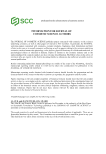329 Topical Apple Derivatives
chemical burns after his mother placed cotton balls with apple cider vinegar over the lesions
for approximately 8 hours.19 While stronger acids are more likely to cause chemical burns,
this case is unique in that a weak acid derived from apples resulted in the chemical burns.19
APPLE CAN ATTENUATE CHEMOTHERAPY-INDUCED ALOPECIA
One experimental study tested the effectiveness of an industrial polycyanidic extract
of Annurca apple (AnnurtriComplex® 6% foam (Mb Med., Turin, Italy) for treating
chemotherapy-induced alopecia in mice (Table II). The study found that the apple extract
enhances mitochondrial activity in hair follicles, resulting in changes in signaling molecules
in the hair follicles. Treated hair follicles damaged by chemotherapy contained structural
and molecular similarities to hair follicles undamaged by chemotherapy. It was found that
inactivating alterations of prostanoid PGF2α is likely the main contributor in the hair
promoting effects of this cosmetic foam.20
APPLE CIDER VINEGAR IS NOT EFFECTIVE IN TREATING ATOPIC DERMATITIS
A controlled clinical trial tested the therapeutic potential of apple cider vinegar in
improving the skin barrier integrity in atopic dermatitis (Table I). Daily topical 0.5%
apple cider vinegar soaks found no long-term effects on skin TEWL or skin pH.21 The
soaks were effective in reducing skin pH, but this effect was not sustained at 60 minutes
post-treatment. 73% of subjects with atopic dermatitis reported mild skin discomfort of
the forearm soaked in apple cider vinegar. One subject with atopic dermatitis experienced
severe pruritus, erosion, and burning of the soaked forearm, which resolved within two days
of discontinuing apple cider vinegar soaks. One healthy subject experienced a nonpruritic
papular rash which resolved without any treatment.21
Another controlled clinical trial tested the potential of apple cider vinegar to alter the skin
microbiome in atopic dermatitis on human subjects (Table II). Daily topical 0.5% apple
cider vinegar soaks were ineffective in altering the skin microbiome or the abundance of
Staphylococcus aureus after two weeks.1
APPLE EXTRACTS CAN CAUSE URTICARIA AND DERMATITIS
The second case report that was reviewed involved a 16-year-old male with atopy. The
topical application of apple, carrot, and potato extracts resulted in contact urticaria
periorally on both hands and on the nape.22 Removal of the extracts cleared any urticaria
and dermatitis.22
DISCUSSION
According to the current evidence, apple derivatives were found to be effective in treating
some dermatological diseases. The strongest evidence was found for treatment of male
pattern baldness, which has 4 double-blind clinical trials with more than more than 20
subjects in each treatment group, 3 of which were tested in human males, and one tested in
mice. Male pattern baldness, the most common cause of hair loss in men, is a multifactorial
chemical burns after his mother placed cotton balls with apple cider vinegar over the lesions
for approximately 8 hours.19 While stronger acids are more likely to cause chemical burns,
this case is unique in that a weak acid derived from apples resulted in the chemical burns.19
APPLE CAN ATTENUATE CHEMOTHERAPY-INDUCED ALOPECIA
One experimental study tested the effectiveness of an industrial polycyanidic extract
of Annurca apple (AnnurtriComplex® 6% foam (Mb Med., Turin, Italy) for treating
chemotherapy-induced alopecia in mice (Table II). The study found that the apple extract
enhances mitochondrial activity in hair follicles, resulting in changes in signaling molecules
in the hair follicles. Treated hair follicles damaged by chemotherapy contained structural
and molecular similarities to hair follicles undamaged by chemotherapy. It was found that
inactivating alterations of prostanoid PGF2α is likely the main contributor in the hair
promoting effects of this cosmetic foam.20
APPLE CIDER VINEGAR IS NOT EFFECTIVE IN TREATING ATOPIC DERMATITIS
A controlled clinical trial tested the therapeutic potential of apple cider vinegar in
improving the skin barrier integrity in atopic dermatitis (Table I). Daily topical 0.5%
apple cider vinegar soaks found no long-term effects on skin TEWL or skin pH.21 The
soaks were effective in reducing skin pH, but this effect was not sustained at 60 minutes
post-treatment. 73% of subjects with atopic dermatitis reported mild skin discomfort of
the forearm soaked in apple cider vinegar. One subject with atopic dermatitis experienced
severe pruritus, erosion, and burning of the soaked forearm, which resolved within two days
of discontinuing apple cider vinegar soaks. One healthy subject experienced a nonpruritic
papular rash which resolved without any treatment.21
Another controlled clinical trial tested the potential of apple cider vinegar to alter the skin
microbiome in atopic dermatitis on human subjects (Table II). Daily topical 0.5% apple
cider vinegar soaks were ineffective in altering the skin microbiome or the abundance of
Staphylococcus aureus after two weeks.1
APPLE EXTRACTS CAN CAUSE URTICARIA AND DERMATITIS
The second case report that was reviewed involved a 16-year-old male with atopy. The
topical application of apple, carrot, and potato extracts resulted in contact urticaria
periorally on both hands and on the nape.22 Removal of the extracts cleared any urticaria
and dermatitis.22
DISCUSSION
According to the current evidence, apple derivatives were found to be effective in treating
some dermatological diseases. The strongest evidence was found for treatment of male
pattern baldness, which has 4 double-blind clinical trials with more than more than 20
subjects in each treatment group, 3 of which were tested in human males, and one tested in
mice. Male pattern baldness, the most common cause of hair loss in men, is a multifactorial








































































